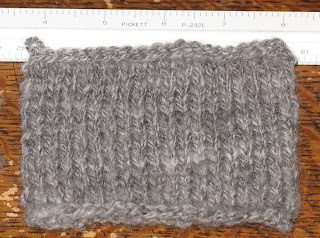No Advisory Caution Required
The indoor part of this story follows. It concerns only the handling of safe, clean wool...complete with photos. (Aren't you glad I didn't take pictures for Part One?)
Dedicated to Amanda
Sometimes someone gives you a gift that you never allowed yourself to even wish for...
That was how I felt when Clancy's mom gave me an antique (working!) spinning wheel out of the blue. It is such a treasure.

And a couple of summers ago Amanda, a friend from high school, offered me all the spinning equipment and roving her late mother had left behind. Little did I know she meant bags and bags of silk and merino blend rovings and this Pat Green drum carder...new in the box...complete with two separate drums for fine and extra fine fibres.
To say I was overwhelmed with surprise and gratitude would be an understatement. For the longest time I didn't even have the courage to take it out of the box and assemble it. And I usually spin in the grease so I never wanted to get this grand tool dirty. But with all the clean wool that Mary had helped me harvest recently just sitting around, it seemed like the right time to conquer my hesitation and produce some bats/roving.
It took about 5 minutes of turning the crank on the drum carder for me to loose my inhibitions and start imagining all the exciting projects and blends I could create with it. In the past week I have carded up all of Ian's moorit katmoget lambs wool (not pictured) and January's longer cream colored fleece (not pictured). Now I've started in on Sextant's lambs wool (above/below). He was a black katmoget with gorgeous crimp and dark color.
As you can see, the staple length is quite short. The lambs were only 6 months old when I sent them to the processor. By spring their staples would have been 4-5 inches....but I couldn't hold on to them that long. So I am experimenting with what I got from them.
After flicking and drum carding the wool, I just had to spin a bit of it. I wanted to determine whether it had a long enough staple for this inexperienced spinner to spin on her drop spindle...or whether it was destined for felting projects. Truthfully, I didn't mind spinning it a bit. But I knitted up this little swatch anyway...just to see how it responded. It is nice and soft. I brought it to church today and I asked two little children to tell me what they thought of it. After rubbing it all over their faces, ears, and necks, they declared it soft enough for a hat or scarf. That is not scientific...but I do trust little people to be honest about the "scratch factor." :) So I think I will attempt a small garment with this fleece.
I also finished plying the last of my Rachel singles this week. One was spun from washed locks and one was spun in the grease. Really had no idea if that was going to affect much when I washed the skein. It didn't seem too. Shown above are two similar Rachel yarns (gray) and two very small Zora yarns (light gray). I plan to make another Rachel scarf and add the Zora to the ends as an accent.
Last but not least...some of the roving Amanda gave to me...a beautiful shimmery gray. I've been spinning it a little at a time for over a year now. At this rate that ball of roving is going to last me a lifetime. :) That is partly why I like to spin on little spindles...like the one shown above that I made out of a yo-yo kit. A small spindle fills up faster and then I get to unwind it or Andean ply it. Keeps me from getting too bored with a single thing. I tend to leap frog around from project to project, depending on how much time and space I have. So it is not realistic to think that huge ball of roving is going to shrink anytime soon. For now, it is my goal to get the rest of the lamb fleeces carded up so I can get the drum carder off my dining room table before Christmas.




